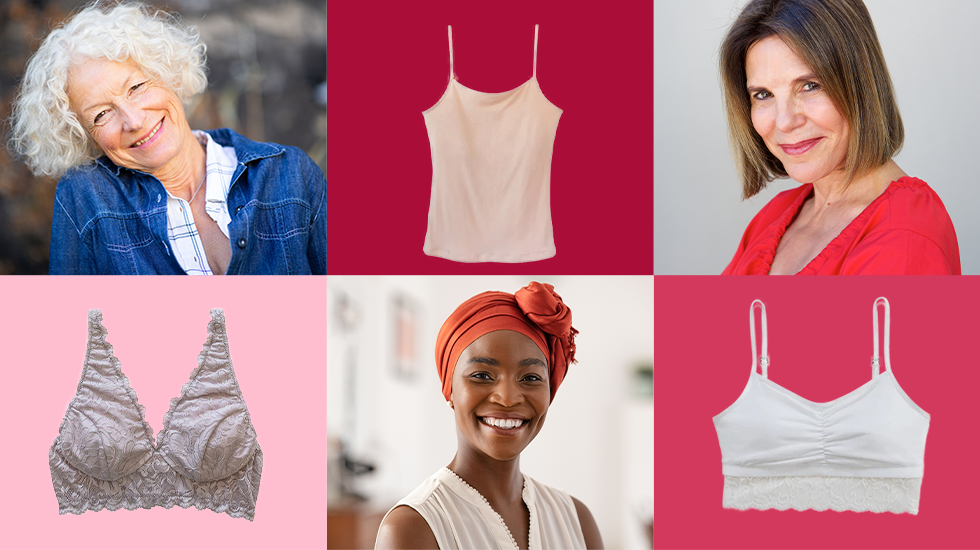



Keira Kotler, a San Francisco-based visual artist and marketing professional, was shocked when her world was rocked by a breast cancer diagnosis at age 40. After her bilateral mastectomy, Keira was even more shocked to realize that one of the greatest obstacles she faced was her inability to find comfortable, supportive—and beautiful—garments to wear to facilitate her healing journey.
After speaking with other breast cancer patients and survivors who shared that they, too, struggled to find functional, comfortable, and attractive garments post-surgery, Keira knew there had to be a better way. She set out to bridge the disconnect between fit, comfort, and beauty for breast cancer patients and survivors, eventually founding Everviolet, an intimate apparel and loungewear brand whose mission is to design garments that nurture all women’s bodies, including those facing breast cancer diagnosis and treatment.
Keira recently shared her personal story, and the story of Everviolet, with the NBCF team. Everviolet is a corporate partner of NBCF.
Keira: I am the founder and CEO of Everviolet, a brand that creates beautiful and adaptive intimate apparel for the immediate and ongoing needs of women after cancer and other physical challenges. The brand was born out of my personal experience with breast cancer—and my struggle to find lingerie that was comfortable, well-fitting, and pretty—following a bilateral mastectomy. My old lingerie no longer fit, and garments designed for after surgery were synthetic, scratchy, and, quite frankly, ugly. I tried on over 200 bras in a 6-month period, and none of them met my satisfaction.
After suffering in silence, I finally started speaking with other women, only to find this issue to be universal. But not just with newly diagnosed women like me. Rather, women who were 10, 20, 30-year survivors claimed there were no brands that offered them the combination of fit and femininity they desired. In speaking with them further, I learned that the inability to start each day free of discomfort, pain, or traumatizing memories represented a barrier to healing on deep psychological and emotional levels. And it was with this realization that I vowed to pay my good prognosis forward and solve this problem for others.
At Everviolet, our mission is to help women reclaim or renew a sense of self and femininity following change, helping them feel comfortable and confident no matter where they are in their journey, and empowering them to feel like people first and patients last. Our mantra is #beautyofchange, because we strongly believe that beauty shines from within. When we face challenging situations, like breast cancer, we’re forced to find strength, resilience, and presence. These are the qualities that make us beautiful, and we all deserve to feel that way every day.
Keira: The needs of women during breast cancer vary based on which type of breast surgery and treatment they undergo, as well as potential side effects or complications they endure. That said, ALL women will come out of breast cancer surgery with extreme sensitivity around the incision site and surrounding tissue. Most often, lymph nodes are removed, so in addition to scars on or around the breast, the underarm can be sore as well. Mobility will also be a consideration–especially for those who undergo mastectomies–and many will have surgical drains for weeks following surgery.
Keira: Garments should be selected based on surgery type, treatment type, and resulting chest types. For example, a camisole with internal drain pockets is a wonderful piece for immediately after surgery. It helps keep surgical drains close to the body and prevents them from pulling or tugging on sensitive skin. We often recommend sizing up during this phase of healing to accommodate swelling.
Garment needs vary widely depending upon whether someone has had a mastectomy vs. lumpectomy. Following a mastectomy, first, there is the drain pocket phase, as described above. Once the drains have been removed and bandages taken off, needs are determined by whether someone has started the process of tissue expanders, gone for immediate reconstruction, or is flat. Bras, at this stage, serve several roles. They can offer support for any natural tissue that is remaining or in the case of a flap reconstruction. These bras also offer discretion, helping conceal scarring or other formations on the skin during this acute healing process. And last, they provide a protective barrier between the surgical site and outside clothing. For all these requirements, soft, natural fabric is recommended in order to promote breathability, avoid irritation, and nurture sensitive skin. Garments with more support will be preferable for those with natural tissue. For those who opt for aesthetic flap closure or have implants/tissue expanders, garments that offer a protective barrier and discretion are best. Following a lumpectomy, doctors often recommend wearing garments that have light compression.
Keira: For those going through chemotherapy and/or radiation, comfort is key! Soft, natural fabrics that can be easily laundered and offer softness are best, as are garments that are adjustable and adapt to swelling and irritation. I also recommend avoiding garments with abrasive hardware such as zippers, rough fasteners such as Velcro, and any synthetic fabrics. Underwires are also not recommended, as they can dig in and cause irritation.
Keira: What many women don’t realize is that after surgery, there can be many ongoing sensitivities long after the body has technically healed. Radiation can leave skin very thin and fragile. Lymph node removal will incur a lifetime risk of lymphedema, or the swelling of the lymphatic system, causing edema (swelling caused by too much fluid trapped in the body’s tissues). Scars can remain sensitive to the touch, and nerves can be permanently damaged. Such conditions may change over time, for both the better and worse, so it’s important to be mindful of any changes and select clothing that doesn’t exacerbate or irritate them.
Choosing intimate apparel that avoids irritating these ongoing sensitivities can be achieved while simultaneously promoting comfort and enhancing one’s femininity. For example, there are several bras that may look like regular bras, but they contain many built-in details to help soothe these ongoing conditions and promote all-day comfort. Adjustable straps and fasteners, along with stretch fabrics are essential for fluctuating bodies. Many women also quickly enter menopause following treatment, both naturally and chemically, so garments that help regulate body temperature and are moisture wicking (hello hot flashes!) are also important.
Keira: Chest types will vary after breast cancer, and our mission is to celebrate all of them. Look for products that fit women with natural tissue, implants, asymmetry, and those who are flat. Every woman deserves to feel comfortable and beautiful.
Beyond the physical side, however, virtually all women who face breast cancer will go through the emotional and psychological process of adjusting to a new body. Whether due to scarring, the loss of breasts, or the emotional trauma of receiving a cancer diagnosis, women are forever changed post-diagnosis. These changes can bring silver linings and profound growth, but they can also bring grief, body image issues, and trauma.
I believe that true beauty resides within, and that no matter what changes our body has endured, the strength and grace we gain from navigating these changes are what make us even more beautiful. We share stories of resilience, with the intent of helping others on their own healing journey. We believe that knowledge is power and that together, we can conquer all challenges. We are real, authentic, and together, we celebrate the beauty of change. #beautyofchange
National Breast Cancer Foundation is here for you and your loved ones. Whether you need support, education, or help during treatment, we have a team dedicated to getting you the help you deserve.
NBCF does not endorse any specific brand or product.
Donations are always appreciated, but there are lots of great ways to get involved.
I recently discovered your site on fb, and I can relate to being diagnosed at 40. Had a DMX, and am searching for intimate apparel that makes me feel good and feels good to wear. I look forward to trying some of your items. I am also a breast cancer model wanting to influence & empower women on instagram who have had similar experiences. I love your mission and what you’re doing. 💓👏